Queen of Oysters Project Presented in Dubrovnik
30 June 2021 - The EU-funded project entitled Queen of Oysters was presented today in Dubrovnik’s Hotel Lero. The project is focused on traditional Mali Ston shellfish farming on Peljesac Peninsula.
Project coordinators Andjela and Ksenija Matic of EventLab alongside the head of the project Vedran Kunica, presented the efforts to local tour guides today. Vedran Kunica is one of Pelješac oyster farmers and a secretary of Stonski Skoljkari – Association of Ston Shellfish Farmers.
Mali Ston Oysters recently received the European Union’s protected designation of origin and protected geographical indication. This is the only instance of such a designation for this specific type of oyster. The European flat oyster (Ostrea Edulis) has been cultivated in the Bay of Mali Ston for centuries. It is one of the most delicious oysters in the world. This is one of its very last natural habitats in Europe. Locals call it the Queen of Oysters. The intent now is to turn this delicacy into a local food brand. While Mali Ston oysters might be popular on a national level, globally they are still to receive the recognition they deserve. Most guests coming to the Dubrovnik area don’t realise they are going to be staying so close to the source of such wonderful seafood.
Project Goals
The Queen of Oysters project is complex and mainly focused on marketing and promotional efforts. It started in February this year and will last for a year. Through it a new visual identity of Mali Ston oysters is envisioned. It is simple and to the point.

One of the goals of the project is communicating the information on local oysters to various stakeholders and raising awareness and consumption of oysters locally. Special workshops with restaurant owners and local chefs are a part of the efforts as well. Restaurants play a key role in the sales of Mali Ston oysters.
Various events were in the organisers' plans as well, but due to COVID-related restrictions, not all are going to happen.
When it comes to promotional efforts, the project is going very strong. There are oyster posters on Dubrovnik Airport and on city buses. Mali Ston oysters are also a part of Croatia Airlines' in-flight magazine. You will be able to see some project posters on Jadrolinija ferries during the summer as well. Local restaurants received hemp fabric promotional aprons featuring the project logo. The response from them is overwhelmingly positive.
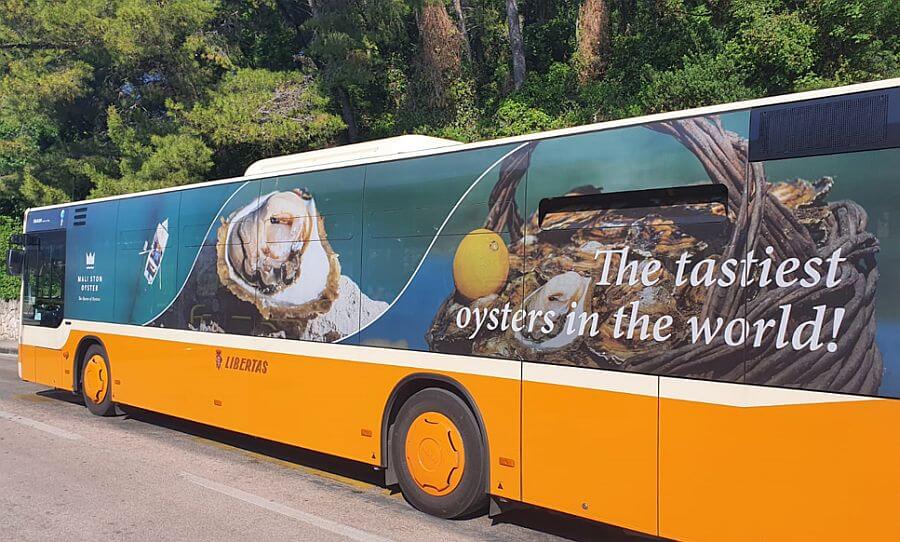
Brochures and booklets
Printed material is especially impressive. Three different booklets and flyers created through the project contain interesting information about the oysters as well and wonderful visuals. They represent a great way of raising awareness of Mali Ston oysters and the area in which they traditionally thrive. The small flyer is going to be in restaurants to inform the guests about Mali Ston Oysters. It will be at the airport as well. The design of the brochure is such as to give a bit more info on history, tradition, and oysters themselves. It also folds out into a lovely photograph. The booklet is serious informational material that contains thorough information on the oyster and the area.
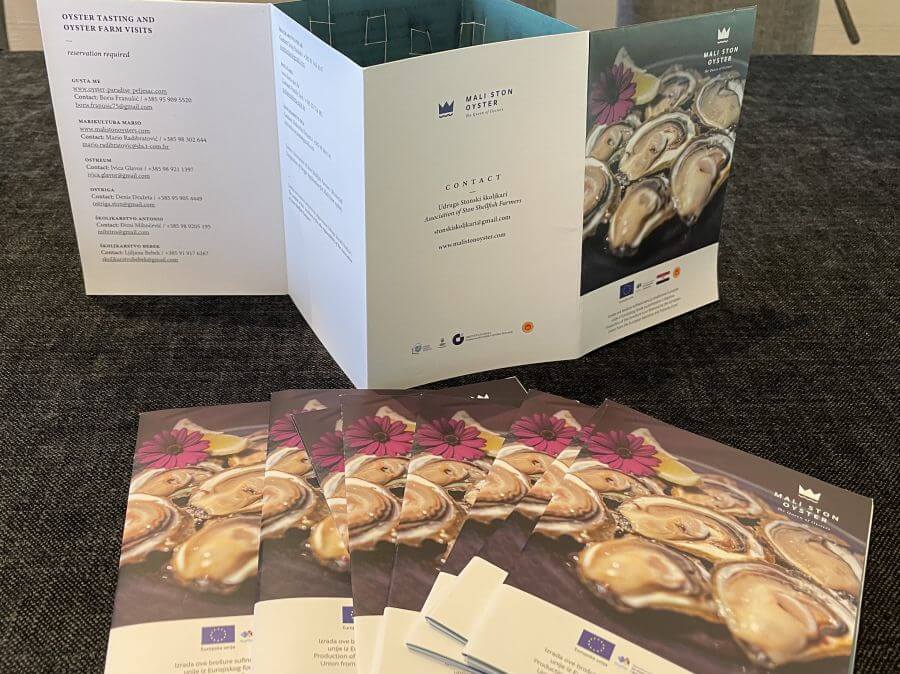
It is clear this project is the long-awaited push to brand Mali Ston oyster a bit better. Sadly, this treasure of local cuisine has spent too much time in the shadows of some other local attractions.
The presentation went off successfully with plenty of questions and suggestions from the auditorium. Also, there were some interesting ideas about how to increase sales and there was much talk about the guests and their experiences.
For more content like this follow Made in Croatia.
Mali Ston Fishers Suffer Huge Losses During COVID-19 Pandemic
March 29, 2021 - Mali Ston oysters are the best around the holiday of St. Joseph. However, due to the pandemic, Mali Ston fishers, who mainly sell oysters in restaurants, have been suffering huge losses for the second year in a row. They manage in various ways and even sell on the doorstep.
At normal times of the year, all roads lead to Ston, Vijesti.hr reports. But due to the bad epidemiological situation, Oyster Days were canceled for the second year. Instead of guests, Tomo Šare takes journalists on a voyage through the Mali Ston Bay.
This type of oyster is extraordinary as it only grows only here in the whole world. It takes 3 years to grow to consumer size; every year in May and June, that cycle begins. The oyster then drops up to a million eggs into the sea, and breeders posit collectors.
"As the sea passes through the collectors, everything catches oysters, mussels, and grass. We aim to make the oysters look like this after a year of growth," explains Tomislav Šare, caterer.
After they are removed from the collector, the so-called cementation follows. "We glue 25 oysters on one and 25 on the other to return to the sea. They grow for another two years, depending on the position as they develop", says Tomislav.
One million oysters are grown in Mali Ston Bay every year, and due to the pandemic last year, only 30 percent of the crop was placed. Shell fishers are suffering huge losses and coping, from the virtual marketplace to selling on doorsteps.
"These are negligible quantities to which we have been accustomed so far. They went to the catering facilities who prepared so much, which is now missing. There are a lot of goods left, and even if it were launched, we would not have enough for our county, let alone exports", says Marija Maškarić, president of the Stonski Školjkari Association.
With one-time assistance and monthly support for job preservation, they requested compensatory measures from the state.
"Both requests were sent for both reference periods, but to date, there is no concrete information for payments. We hope, we expect, we believe, we are promised. That would be a great help for shellfish farmers to continue production", adds Marija Maškarić.
The Mali Ston oyster recently received the European protected designation of origin. As much as half a million kuna of European funds is worth a marketing project that should help shellfish in corona crisis times.
"The product is presented as well as possible, and that actually aims to increase consumption per person to the visitor. We cannot change our county's attendance. We cannot change the structure of guests. What we can do is present our product to be sold in as large a quantity as possible", explains Vedran Kunica, project manager of the protection of Mali Ston oysters.
Instead of the traditional oyster festival on the holiday of St. Joseph, the Oyster Queen project was presented. "Every area has sights that are a must-see, to make special oysters from Mali Ston, an unavoidable product for every visitor to our County," says Vedran.
While we wait for the restaurants to open and the tourists to return, oysters are sold on doorsteps.
"The best, the most delicious, and the top quality, it's a shame not to consume it now. The situation is as it is; there are always breeders who sell on the farm, whoever has the desire can always stop by to consume oysters", says the president of the Ston shellfish association.
They are also preparing a bilingual extensive monograph on Mali Ston Bay's natural features and the long tradition of shellfish farming.
For more about lifestyle in Croatia, follow TCN's dedicated page.
Are Mali Ston's Precious Oysters Now Norovirus Free?
We reported recently on the truly tragic situation that Ston's precious oysters had found themselves stuck in. In short, this famed gem of southern Dalmatian cuisine had fallen victim to Norovirus after septic tanks weren't being cleaned out properly, and the traditional Days of Mali Ston Oysters, which was due to be held on the 16th of this month, had to be cancelled for health and safety reasons.
While the news was indeed as sad as it was alarming, has a solution to Mali Ston's Norovirus problem been found?
As Morski writes on the 11th of March, 2019, there appears to no longer be any detected presence of the potentially deadly Norovirus in Mali Ston. This was confirmed to Dubrovacki list by dr. Sc. Eddy Listeš from the Veterinary Institute of Split.
The last tests on the matter were carried out last Friday, but unfortunately the paperwork confirming the absence of Norovirus from the area and its beloved oysters has not yet reached those to whom such a document of confirmation is of vital importance.
To briefly recall, back at the very beginning of March, discovered via the regular sampling of the seawater and shellfish (oyster) quality, the presence of Norovirus was established.
Norovirus, otherwise of human origin, is the cause of infections of the digestive system. Norovirus wreaks havoc in the human digestive system, causing violent diarrhoea, vomiting, the inability to hold any food or liquid down, often resulting in dehydration and the need for emergency hospital treatment, and sometimes even in death. It is transmitted from person to person, via the fecal-oral route, typically through food contaminated by the fecal matter of infected persons and contact with surfaces contaminated with Norovirus. Norovirus is highly contagious and its symptoms, which as described above are often severe, tend to manifest quickly.
Having the potentially massive health issues that could be caused by the consumption of Mali Ston oysters which have come into contact with Norovirus in mind, a decision was made by the organiser of the traditional Day of Mali Ston Oysters to cancel the beloved event, writes Dubrovacki list.
Vlado Onofri, a respected senior scientific advisor at the University of Dubrovnik said that septic tanks, which in themselves would not be problematic were the situaton involving just several family houses, were the cause of the Norovirus issue. The situation that has arisen in the Dubrovnik area as a whole is that there are now a lot of apartments and far too many people, without anyone properly dealing with the septic tanks and the dangerous bacteria and viruses that gather there.
"Septic tanks can't withstand that pressure and it (everything that builds up in them) has to come out somwhere. That's it. We've sh*t on ourselves,'' stated Onofri.
Make sure to follow our dedicated lifestyle page for more. If it's just Dubrovnik and southern Dalmatia you're interested in, give Total Dubrovnik a follow.
Has Croatia Ruined its Oysters? According to an Expert, Apparently...
Have Croats managed to destroy their beloved Ston oysters with feces? Maybe. It sounds like another negative and inflammatory headline about how nobody can do anything right, but according to one respected expert, this might really be the case.
Norovirus is a potentially dangerous virus of the Caliciviridae family which causes 19 to 21 million illnesses, 56,000 to 71,000 hospitalisations and as many as 570 to 800 deaths per year according to the Centres for Disease Control and Prevention. Often called stomach flu, Norovirus is highly contagious, and is known to mercilessly tear through populations of people in concentrated areas, cruise ships are a particular favourite playground for the virus.
Symptoms, which include chronic vomiting and diarrhoea can become very severe very quickly, rendering a person unable to hold anything down, eventually leading to extreme weakness, sudden weight loss, dehydration, and the need for emergency treatment. Now we've covered the basics of this microscopic devil, how has the presence of Norovirus managed to infiltrate Ston's long oyster-based traditions? Perhaps more importantly, just how have the Croats succeeded in allowing such danger to seriously threaten Ston's most prized gastronomic offer?
As Index writes on the 5th of March, 2019, Vlado Onofri, a scientific advisor at the University of Dubrovnik spoke to Libero portal and explained that the Croats have indeed managed to destroy southern Dalmatia's internationally adored gourmet delicacy. He said that the cause was the unsolved issue of the area's sewage network, more specifically septic tanks that are full, and not being emptied. Such conditions lead to the presence of potentially dangerous viruses and bacteria, including the potentially fatal Norovirus.
Because of the presence of Norovirus on three of the five control points on which Ston's beloved oysters are grown, the Day of Mali Ston Oysters, which was supposed to take place on March the 16th, has now been cancelled for health and safety reasons.
"I'm sorry for the hospitality and catering facilities and for oyster lovers, I know they'll lose out on a lot because of this, but some things need to be said in order to start sorting things out," said Vlado Onofri rather bluntly, who claims that when it comes to Croatia's very unfortunate oyster situation, there's nobody to blame but the Croats themselves.
"There will certainly be a reaction after all of this, but come on, have someone show me that they've paid for the emptying of the septic tanks! Nobody will show you that! Except the Koruna restaurant, which I know keep their oysters in pools and they're absolutely fine for consumption. That's the only example [of that] in Ston.
The entire area hasn't had its sewage situation solved adequately, and it was the obligation of the state to resolve it at the beginning of the eighties when the sewage [system] was being done. Mali Ston and Veliki Ston were meant to be connected to the entire sewage system, this wasn't done and now after so many years, it's time to pay! You know how it goes with septic tanks, when there were small households, there were small quantities, but now there's a lot more, it's all too full up, and nobody is emptying them!" Onofri said.
This isn't the first time a virus has appeared in these oysters.
"Three years ago, there was a problem. People got food poisoning, started having diarrhoea, vomiting... that's Norovirus, viruses aren't harmless things, that virus can live for hundreds of years in sludge, when it comes across live tissue, it becomes virulent again (a pathogen's ability to infect its live host) because it crystallises its capsomer (a covering of protein that protects the genetic material of a virus). I'm good with virology and I know what I'm talking about because I did a Master of Science in the 1980s, and later a doctorate in Ston,'' Onofri explained, backing up his claims.
"We're dependant on the whims of humans and nature"
He also provided a response to the question of how long this dire situation might last:
"The oysters can quickly get rid of the virus if they're in clean water, meaning that we need purification pools that we don't have. There was an idea to make them in Bistrina, and I personally brought plans from France to show what this should look like. There were ideas thrown around about doing that, but it hasn't been done. This is an absolute necessity, for when such things do happen, to end up with a sanitised and proper product. Now we're depending on the whims of humans and nature when it comes to how our products end up! The pools weren't made because of a protected reserve where nothing at all can be constructed,'' stated Onofri.
Make sure to stay up to date by following our dedicated lifestyle page.
Mali Ston, a Hidden Oyster Gem on the Peljesac Peninsula
October 2, 2018 - Croatia's Adriatic coast has many hidden gems, but for oyster lovers, there is only one address - Mali Ston.
EU Protection for Oysters from Mali Ston?
Could Mali Ston's most famed produce soon acquire special protection at the European level?
Conde Nast Things to Do Before You Die: Eat Oysters in Croatia!
Most of us can make lists all day long, but we don’t always accomplish all the things that were important enough to make the list in the first place. One particular list many of us make is of the things we want to do or places we want to see before we die also called our bucket list. So in case you haven’t made your own yet Conde Nast Traveler went ahead and made one for you. They focused on just one continent and narrowed down the 50 Things to Do in Europe Before You Die.
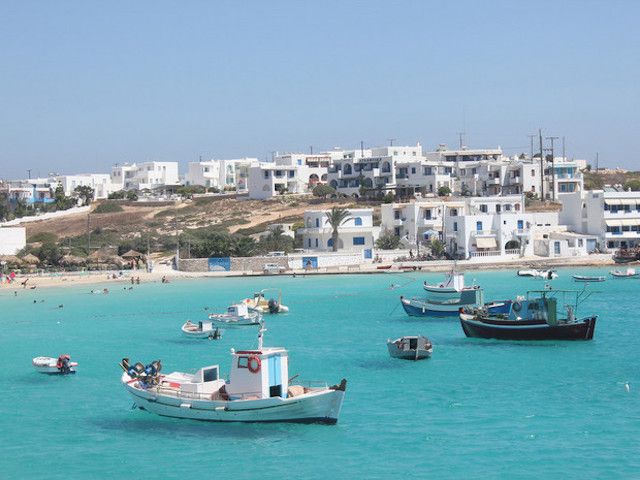
Croatia made the cut and came in at lucky #7 among it's European powerhouse neighbors such as; Amsterdam, Italy, Ireland, Spain, France, Greece, the UK and many more. Their top travel experts agree that everyone’s bucket list should include eating oysters in Croatia. More specifically from the bay of Mali Ston where they’ve been harvested since Roman times and their delicate flavor praised for centuries. Another insider tip is to wash them down with a glass of posip or white wine.

Other suggestions on the list were; skinny dipping in Sweden, sleeping in a car in Stuttgart or a castle in Scotland, taking a black taxi tour of Belfast, a train over a bridge connecting Sweden and Denmark or a carriage ride through Krakow. In Europe, traveler’s can also taste truffles in Italy, visit the highest beer garden in Germany or a viking community in Roskilde, attend a fire festival in Spain, a summer music festival in Serbia or the Balshoi Ballet in Moscow.


Besides eating oysters from Ston, I’ve managed to make a small dent in their list by marveling at the David in Florence, La Sagrada Familia in Barcelona and impressive Swiss Alps as well as getting lost in the louvre in Paris, on the tourist trail in Bruges and on the colorful streets of Lisbon. I’ve also been fortunate enough to enjoy flamenco in Spain, the Opera in Vienna, gelato in Rome, a beer or two in Prague, a cocktail under the Eiffel Tower and most recently took a thermal bath in Budapest on my birthday, but there’s still so much more!
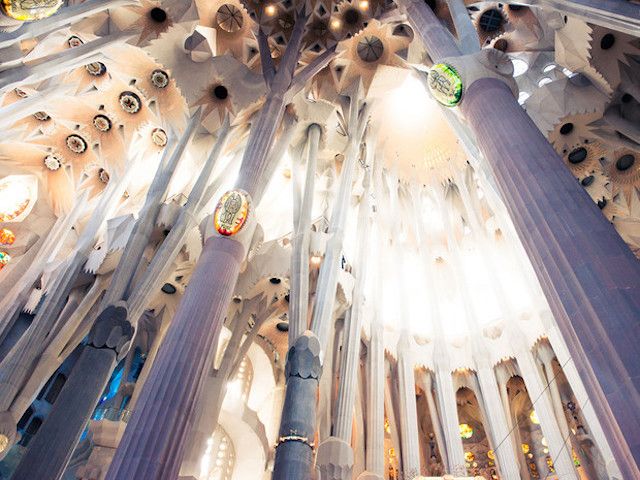
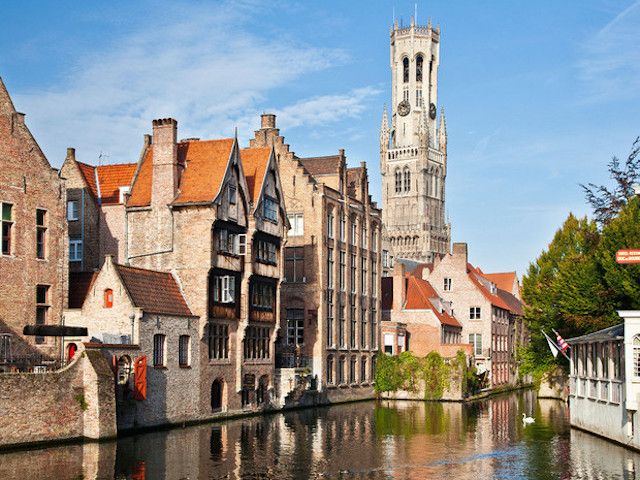


At the top of my Conde Nast Traveler to-do-list; the northern lights in Iceland, Giant’s Causeway in Ireland, Acropolis in Athens, canals in Amsterdam, shopping the Grand Bazaar in Istanbul, sailing the Greek Isles, walking the Berlin Wall, tasting afternoon tea in London and trekking to Sages, Portugal; the end of the European continent.




As we can see, Europe and the world is our delicious oyster, but take it from the pros and don't leave eating them in Croatia off of your bucket list!
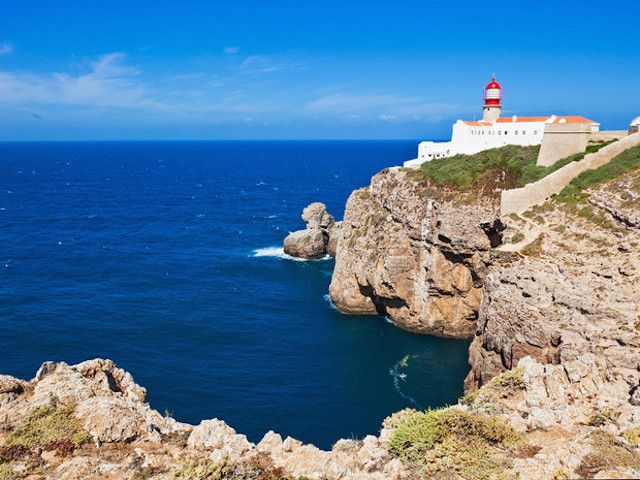
Photos: Conde Nast Traveler
Festival of Oysters this Weekend in Mali Ston
Love them or hate them, the significance of this festival is not to be missed.


